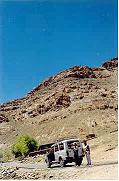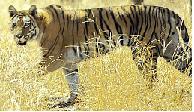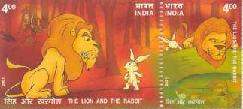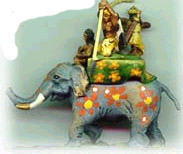Adventure
'I believe any trip in search of wildlife can be coupled with physical activity and elements of cultural diversity to form a thrilling opportunity ' : John
H.Eickert
 “Julay” is the traditional greeting in the most northern province of India. Ladakh is found between the windswept Tsangpo Plateau and the snow
covered heights of the Middle Himalayas. In this article, I will provide an overview of the Zanskar area of Ladakh. I believe any trip in search of wildlife can be coupled with physical activity and elements of cultural diversity to form a thrilling opportunity.
Ladakh or “Land of White Copper” has two main rivers. The Indus, which flows into India via the Tibetan Plateau and the Zanskar, which joins the Indus below the capital of Leh and has carved the “Grand Canyon of India.” The Zanskar offers one of the worlds
great rafting opportunities. The Zanskar valley holds one of the last surviving areas of the Indo-Tibetan culture and some unique and endangered wildlife.
“Julay” is the traditional greeting in the most northern province of India. Ladakh is found between the windswept Tsangpo Plateau and the snow
covered heights of the Middle Himalayas. In this article, I will provide an overview of the Zanskar area of Ladakh. I believe any trip in search of wildlife can be coupled with physical activity and elements of cultural diversity to form a thrilling opportunity.
Ladakh or “Land of White Copper” has two main rivers. The Indus, which flows into India via the Tibetan Plateau and the Zanskar, which joins the Indus below the capital of Leh and has carved the “Grand Canyon of India.” The Zanskar offers one of the worlds
great rafting opportunities. The Zanskar valley holds one of the last surviving areas of the Indo-Tibetan culture and some unique and endangered wildlife.
To reach Ladakh and the Zanskar one can fly from Delhi, but I recommend going overland. Leh has an elevation of over 11,000 feet and acclimatization can be a problem. Headaches and fatigue are a common complaint following arrival. The overland road eases
this problem and offers spectacular scenery and wildlife viewing. The bumps, grinds, and dust from overland travel are merely an introduction to this high cold desert. While traveling by bus or private car there is always the possibility of viewing brong
dong (wild yak), kyang (wild horse), nyan (bighorn sheep), chim or sometimes chiru (Tibetan antelope and source animal for the mythological “golden fleece”), goa (Tibetan gazelle) and the greater hunter of the high mountains the snow leopard. Some of the
oldest monasteries extant on the Tibetan Plateau are found in Ladakh and are a joy and mystery to tour. An interesting side trip while acclimatizing in Leh is the Khardung La. This motorable pass ascends to 18,385 feet and is proclaimed the highest road
in the world!
Several days’ drive from Leh is the
put in for a rafting descent of the Zanskar. Tongri village is deep in the Zanskar not far from the confluence of the two forks of the river, the Doda and the Tsarnpchu. This is an important barley-growing region and at certain times of the year, it is possible
to view black-necked cranes, Bactrian magpies, Turkoman rock pigeon, (common here) and desert wheateaters. The region is home to 170 species of bird, most uncommon in other parts of India.

From Tongri the river drops through
a deep gorge with walls rising to 3000 feet. Bar-header geese, bearded vulture, golden eagle, marmot, and ibex are common. The river descent should take five or six days. The water is fast and cold and the experience rounds out an amazing adventure. Be
prepared to feel your heart pound! Rafting trips are available from Delhi or Leh, 14 days should be considered a minimum from Delhi and eight days from Leh. July through September is the best time. Trips of shorter duration are available with considerable
compromise to safety. Take the time and take your time! Enjoy.
( Photograph of road to Leh by
Thomas Chacko)
Contributed by
John H.Eickert
Num Bum Adventures
or call 406-777-2228.
|
Answers To Quiz Of The Month
Last month no one has given all right answers!
Right Answer to "Are we poisoning our Home Planet?"
|
| 1.How long will it take for plastic to biodegrade? |
| 1 million years |
100 years |
1000 years |
|
| 2.How long will it take for cotton rags to biodegrade? |
|
| 3.How long will it take for a styrofoam cup to biodegrade? |
| 10 years |
100 years |
Eternity |
|
| 4.How long will it take for a tin can to biodegrade? |
| 1-2 years |
10 -20 years |
50-100 years |
|
| 5.Delhi belches out over ----------------tonnes
of solid waste every day |
|
| 6.A family's weekly garbage production
is ----------------kgs now as against 7 kgs in 1980 ( for Delhi) |
| 40-50 kg |
12-15 kg |
20-30 kg |
|
| 7.Recycling one ------------------can
save enough energy to run a TV set for 3 hrs. |
| Styrofoam cup |
Glass bottle |
Aluminium can |
|
| 8.Of the 28
commonly used pesticides at least ----------------are carcinogenic |
|
| 9.Every ------------------------the US wastes nearly 90%
of recyclable newspapers. This wastes about 500,000 trees. |
|
| 10.Recycling all your home's waste newsprint,
cardboard, glass and metal can reduce
-------------emissions by 856 pounds a year. |
| Sulphur Dioxide |
Carbon Monoxide |
Carbon dioxide |
|
Please try our quiz for the current month at
Elephants-Part II
|
Burning Issues
M.K.S. Pasha,
Director, Wildlife Conservation & Research
Wildlife Protection Society of India, New Delhi.
The tiger
population in the country is officially estimated to be 3,000 - 3,500. Many of the tiger populations across the nation, particularly those outside protected
reserves, face a variety of threats, including habitat fragmentation, encroachment, and poaching and developmental projects. These problems are directly or indirectly linked to anthropogenic factors.
Decades of scientific research on tigers and their prey have provided us with a set of guidelines to develop and design protected areas to help the species survive.
However, these reserves protect only a fraction of the tiger habitat, and most are under severe human pressure. In the last few years, tiger poaching has increased dramatically, fueled by illegal trade in tiger body parts.
 Large development projects, such as mining and hydroelectric dams, constructions of highways are also taking their toll on the tiger's habitat. In the past
few years, thousands of square kilometers of forestland have been diverted and destroyed to facilitate such projects. Though mostly outside the protected network, the loss of this vital habitat will have serious repercussions on tiger conservation in India. Large development projects, such as mining and hydroelectric dams, constructions of highways are also taking their toll on the tiger's habitat. In the past
few years, thousands of square kilometers of forestland have been diverted and destroyed to facilitate such projects. Though mostly outside the protected network, the loss of this vital habitat will have serious repercussions on tiger conservation in India.
As per the WPSI crime database a total of 95 tigers are known to have died in 1994, 89 tigers killed in 1997 and 36 tigers killed in 1998. These figures, however,
are incomplete and represent only a fraction of the actual poaching activity in India. Despite all these problems, India still holds the best chance for saving the tiger in the wild. Tigers occur in 18 States within the Republic of India, with 10 States reportedly
having populations in excess of 100 tigers. There are still areas with relatively large tiger populations and extensive tracts of protected habitat.
The Project Tiger was launched in 1973, with the goal to save the tiger and its habitat in India. With an initial list of 9 Tiger Reserves, this Project covers
27 Tiger Reserves across the country, covering an area of 37, 761sq. km. Though this Project has tackled various issues over the past 20 years, it has not been able to keep pace with the rapid changes that have not only changed the tiger landscape but also
have increased the pressures on it. As the poaching of tiger and illegal trade in its body parts has become a global issue. Saving the tiger is not only the duty of the forest staff and the government but the onus lies on every citizen of this country. Together
we have to work hard
 and make sure that the stripes do not vanish from the forest. and make sure that the stripes do not vanish from the forest.
Vanishing Stripes
Tigers are hunted for their skin,
bones, and body parts
Save the Tiger
|
Did You Know ?
Largest Timber Library: The library at the Forest Research Institute at Dehra Dun has 9,627 Indian samples and 10,248 foreign samples.
Oldest botanical gardens: The National Botanical Gardens in Calcutta, originally called the Royal Botanical Gardens, were established in 1787 at Howrah in West
Bengal, by the side of the Ganges. The gardens cover an area of 112 hectares, divided into 25 groups where 4500 species of plants and 30,000 trees are grown. The National Botanical Gardens are the second largest in the world.
Largest Leaf: The leaf of the water lily (Victoria amazonica) is the largest of all leaves. It measures 1.5 m in diameter. A six-year old can easily sit on it.
The leaves can be seen at the Botanical Gardens in Calcutta.

Correction in last month's 'Did you know?'
The specific gravity of the lightest wood and the heaviest wood was mentioned as .12-.15 (the same) by mistake. The error was pointed out by one of our readers, Mr. Nagendra Krishnan. Thank you!
Specific gravity of the lightest wood is 0.12-0.15 and of the heaviest wood is 1.25
|
News and Views
News...............
Dr. Susan Sharma
This month we are flagging off two promotions. One is to promote domestic eco-tourism. Our banners are there on the Indian Railway
Information pages ( FAQ, Break Journey Rules and International Tourists) announcing our customized eco-tours through our empaneled tour operators.
The second is a three month long focus on 'Conserving the Indian Elephant'. Our team has created a touching screen saver on elephant behaviour ( Photographed by
Karan Bisht, Tour Guide, Corbett National Park) which tells a story. What can this story be? Are we humans sensitive enough to understand the emotions and anxieties of these gentle pachyderms? We would request all of you to participate in the online story
writing contest, the details of which are being announced separately.
Our online chat sessions are picking up slowly. You can read a short transcription of this month's chat elsewhere on the homepage of Indian wildlife Club. This
will now be a regular monthly feature. To give more meaning and focus to the chat sessions, we are going to center the chat on a pre- announced topic in future. The topic for next month's chat will be 'Migratory Birds of India". So please be there on 18th
of December between 7.30PM and 8.30 PM (IST).
And Views………….
TheTortoise and the Geese
Remember The Most Wonderful Stories of Childhood?

..……………If you were with me, I would love to talk to you about this beautiful world of ours, about flowers, trees, birds, animals, stars, mountains , glaciers and
all the other beautiful things that surround us in the world. We have all this beauty all around us and yet, we, who are grown-ups, often forget about it and lose ourselves in our arguments or in our quarrels. We sit in our offices and imagine that we are
doing very important work.
I hope you will be more sensible and open your eyes and ears to this beauty  and life that surrounds you. Can you recognize the flowers by their names and the
birds by their singing? How easy it is to make friends with them and with everything in nature, if you go to them affectionately and with friendship. You might have read many fairy tales and stories of long ago. But the world itself is the greatest fairy tale
and story of adventure that was ever written. Only we must have eyes to see and ears to hear and a mind that opens out to the life and beauty of the world. …… and life that surrounds you. Can you recognize the flowers by their names and the
birds by their singing? How easy it is to make friends with them and with everything in nature, if you go to them affectionately and with friendship. You might have read many fairy tales and stories of long ago. But the world itself is the greatest fairy tale
and story of adventure that was ever written. Only we must have eyes to see and ears to hear and a mind that opens out to the life and beauty of the world. ……
Excerpts from letter written by Jawaharlal Nehru, the First Prime Minister of India on Dec 13 1949, to the children of India.
|
Understand The Animals
Endangered Birds
 Schedule I, Part III of the Indian Wildlife (Protection) Act, 1972 lists rare and endangered birds which are totally
protected throughout the country, live or dead or part thereof. They include Andaman Teal, Assam Bamboo Partridge, Bazas, Bengal Florican, Blacknecked Crane, Blood Pheasants, Cheer Pheasant, Eastern White Stork, Forest spotted owlet, Great Indian Bustard,
Great Pied Hornbill, Hawks, Hooded Crane, Hornbills, Houbara Bustard, Humes Bartailed Pheasant, Indian Pied Hornbill, Jerdon's Courser, , Lammergeier, Large Falcons, Large Whistling Teal, Monal pheasant, Mountain Quail, Narcondam Hornbill, Nicobar Megapode,
Nicobar Pigeon, Osprey, Peacock-Pheasant, Peafowl or Indian Peafowl, Pinkheaded Duck, Scalter's Monal Pheasant, Siberian White Crane, Tibetan Snowcock, Tragopan-Pheasant, Whitebellied Sea Eagle, White-eared Pheasant, White Spoonbill, and Whitewinged Wood Duck. Schedule I, Part III of the Indian Wildlife (Protection) Act, 1972 lists rare and endangered birds which are totally
protected throughout the country, live or dead or part thereof. They include Andaman Teal, Assam Bamboo Partridge, Bazas, Bengal Florican, Blacknecked Crane, Blood Pheasants, Cheer Pheasant, Eastern White Stork, Forest spotted owlet, Great Indian Bustard,
Great Pied Hornbill, Hawks, Hooded Crane, Hornbills, Houbara Bustard, Humes Bartailed Pheasant, Indian Pied Hornbill, Jerdon's Courser, , Lammergeier, Large Falcons, Large Whistling Teal, Monal pheasant, Mountain Quail, Narcondam Hornbill, Nicobar Megapode,
Nicobar Pigeon, Osprey, Peacock-Pheasant, Peafowl or Indian Peafowl, Pinkheaded Duck, Scalter's Monal Pheasant, Siberian White Crane, Tibetan Snowcock, Tragopan-Pheasant, Whitebellied Sea Eagle, White-eared Pheasant, White Spoonbill, and Whitewinged Wood Duck.
 Jerdon's Courser or Double Banded Courser Jerdon's Courser or Double Banded Courser
is a globally threatened species listed as 'Critically Endangered' on the IUCN Red
List, one of seven Critically Endangered species in India, where it is endemic. It was thought to be extinct until rediscovered in Andhra Pradesh in 1986. Though the bird is nocturnal, it is not very shy. It is attracted by imitating calls. A very small
vulnerable population remains restricted to a small area of the state.
The photograph on the right was taken by amateur photographer Mr. Vinod Goswamy, Executive at Exotic Journeys(P) Ltd, New Delhi on 9th Sep1994.
In his "Book of Indian Birds" Salim Ali describes the bird as having the size of a partridge and lapwing like in its looks. ( The drawing on the left is from the book).
The book describes the bird's distribution thus:
Indigenous to peninsular India though its nearest relations are African. Only known from the Godavari Valley in Andhra. First discovered in 1848; last authentic record
in 1900. After careful research rediscovered on 12 January, 1986 at Lankamalai Sanctuary, Cuddapah District, Andhra Pradesh.

Although Jerdon's courser is now seen relatively regularly at a few sites, little is known of its ecology, habitat use, or numbers and distribution. A research project,
funded by the Darwin Initiative is being undertaken by the Bombay Natural History Society, with help from the Andhra Pradesh Forest Department.
For attempting to see this bird, one may contact the Chief Wildlife Warden of Hyderabad.
For more information on the current status of the bird you can contact
Bird Life Society of Andhra Pradesh
P.O Box 45, Banjara Hills P.O
Hyderabad
( Contibuted by
Mr. G.T Ramani
)
|
Zoo
 Toby Ninan retired from Delhi Zoo about two years back. With his varied experiences with the wild animals in the zoo, he is the right person to
direct your queries to. Hear what Ninan has to say about his life and chosen career! Toby Ninan retired from Delhi Zoo about two years back. With his varied experiences with the wild animals in the zoo, he is the right person to
direct your queries to. Hear what Ninan has to say about his life and chosen career!
Elephants, though very intelligent, have their moods - strong likes & dislikes - like a large number of us. They are a great hit at all ceremonial occasions &
look very majestic especially when they are decked up in colorful trappings like ornate 'howdahs', richly embroidered back cover up & golden headdresses.
The Republic Day Parade is one of those occasions when elephants are taken out in parade with the children awarded for bravery, riding these majestic animals.
For a number of years,I had the privilege of leading the elephant brigade but my function was purely that of keeping some 50 paces behind the fire brigade - these
being mechanical would & could easily keep a constant speed but the elephants had a very leisurely pace & could easily fall behind the slot which was allotted to them; this was especially bad because the folk dancers (following the elephants) were again notorious
for stepping out of their slot. 
I had another job to do and this was to see that the elephants were behaving properly. If (God forbid) any one of these animals ran amuck, they would have to
be put down by the sharp shooting army escort under my command.
Well everything had gone off well & the elephants, brave children and army escorts, were all waiting for their turn near the parliament house. I certainly could
not have led the parade in my ragged jeans & scruffy shirt so I was grandly dressed up in an ornate achkan which once had belonged to the Diwan of a princely state in Himachal Pradesh. The Diwan's grandson was a colleague of mine & he graciously lent the
dress for this occasion. I wore a pair of churidar pyjamas with a beautiful turban on my head & I also wore some ornate "joothies".
I was standing in front of one of our elephants "Bholi". Now, "Bholi" was a somewhat bad tempered or rather a moody animal but we (she & I) used to get along
like a house on fire. What I & any one else did not realise was that I had been given a generous spray of "Attar" i.e; the strong smelling rose scent which nearly proved to be my last day on earth. "Bholi" just could not smell my body scent & she got very
upset by a strangely dressed being, enveloped by an upsetting scent, standing nonchalantly in front of her.
She made up her mind that this being would have to pay a dear price for this behaviour & slowly but surely she gathered up the backdrop of the flowing "achkan"
in her trunk & was just about to yank me off the ground when I felt a gentle tug on the "achkan" & just in time I realized that I was about to be lifted up & smashed to the ground by an upset elephant. I could only do one thing & that was to yell "Bholi".
Hearing the familiar sound of her name she let go of the "achkan". Though I was slightly shaking, I went up to my pachyderm friend & apologized profusely for my lack of manners. She accepted this graciously & when her turn came to join the parade, behaved
really well so that I could reward her with a couple of "laddoos" when we were done & ready to go back to the zoo.
Bholi had previously belonged to a princely family & was used to being served,huge " thalifuls" of laddoos on ceremonial occasions by the princesses so this was
hardly a snack but she understood the gesture & I had learnt a good lesson!
|